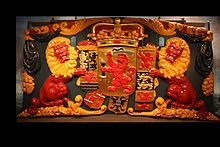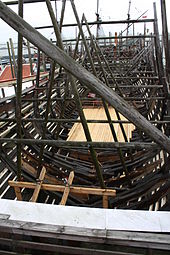De Zeven Provinciën (ship, 1665)
|
Model of De Zeven Provinciën in 1:87 scale
|
||||||||||||||
|
||||||||||||||
|
||||||||||||||
|
||||||||||||||
|
||||||||||||||
The liner De Zeven Provinciën was the flagship of Admiral Michiel Adrianszoon de Ruyter in the Second and Third Dutch Wars . The naming takes up the name of the state Republiek der Zeven Verenigde Provinciën .
history
The ship was launched in Delfshaven in 1665 . The De Zeven Provinciën was a two-decker with 80 guns. Its dimensions were 163 feet in length, 43 feet in width between the frames, and 16.5 feet (1 Amsterdam foot = 28.3 cm) draft . It was built as part of a fleet building program initiated by the States General in 1664. This program provided for three sizes with a total of 24 ships, whereby only the lower limit was set in each case. The Zeven Provinciën was the first ship, belonged to the largest charter and was built for the Admiralty Maze. Only with the construction of the three Amsterdam ships Gouden Leeuw , De Witte Oliphant and Witte Dolphin 1666–1667, it was clearly outbid in size and number of guns.
She fought in the Second (1665–1667) and Third Dutch War (1672–1678) as the flagship of the entire Dutch fleet. Each of the five Dutch admirals had a lieutenant admiral and accordingly lower admiral ranks. That is why there were a large number of flagships in the fleet. Only the Zeven Provinciën had the fleet chief on board with de Ruyter. It was often badly damaged in the fighting. For example, in the four-day battle , she had to go leeward on the second day because the mainmast had been blown away. In addition to the damage to the hull and the rigging, the problem was the lack of the orientation point of the large flag in the top for the rest of the fleet. It was badly damaged in the Battle of Barfleur against the French in 1692 and was scrapped in 1694.
Construction
The advantage of Dutch warships over English and French ships was the shallow draft, which often allowed them to navigate waters that the enemy could not pass through. The large ships in the Dutch fleet were also wider in the waterline. Both together resulted in a calmer position of the hull in the water and a lower degree of heel . This important effect shows up again and again in the sea battles. While other ships had to close their lowest gun ports so that no water could penetrate there, the Dutch ships could also use the heavier artillery set up in the lowest deck. In addition, a calmer position in the water also made it possible to release the guns more calmly from these platforms, thus increasing the possibility of a hit.
However, this also had disadvantages. The ships were smaller than their opponents not only because of cost savings. So there was no space to operate the guns and for supplies. But the carrying capacity for more guns with larger calibers was also limited. Thus, the Dutch fleet was always dependent on other elements of naval warfare if it wanted to be victorious. This included the level of training and motivation of the crews from admirals to seamans as well as the larger number of ships and their better equipment.
The replica
A replica of De Zeven Provinciën has been manufactured at the Batavia shipyard in Lelystad , Netherlands , since 1995 . They survived a fire in the shipyard in 2008 unscathed.
literature
- Gerard Brandt: Het Leven en Bedryf van den Heere Michiel de Ruiter . Amsterdam 1687.
- JR Bruin (Red.): De 7 Provinciën. A nieuw schip for Michiel de Ruyter . Uitgeverij Van Wijnen, Franeker 1997, ISBN 90-5194-135-8 .
- GC Dik: De Zeven Provincien . Uitgeverij van Wijnen, Franeker 1993, ISBN 90-5194-091-2 .
- Ad van der Zee (Red.): De 7 Provinciën. Reconstructie van een oorlogschip uit de 17de eeuw . Cahier 1, Bataviawerf, Lelystad 2004, ISBN 90-73857-06-6 .
- Ad van der Zee (Red.): De 7 Provinciën. Reconstructie van een oorlogschip uit de 17de eeuw . Cahier 2, Bataviawerf, Lelystad 2006, ISBN 90-73857-07-4 , published with ISBN 978-90-73857-07-4 .
Web links
- Website of the Dutch Navy about the ships of this name (Dutch)
- Information about the original Zeven Provincien on the website of the Bataviawerf (netherlands)
- Dutch Zeven Provincia Site




